Don't Be Dumb When You Draft A Zero RB Team In 2025
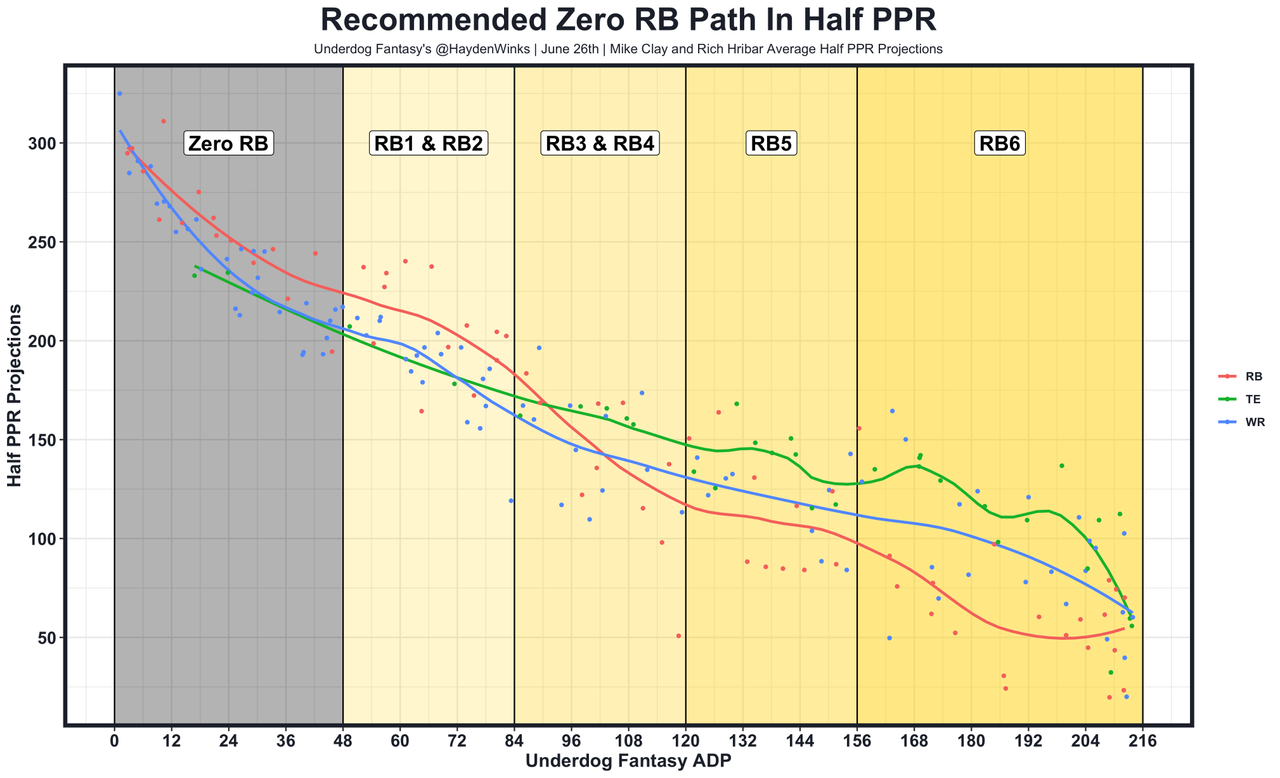
I wrote my initial Zero RB strategy column a couple years ago after studying best ball teams, and I found a few big mistakes many drafters are making. In short, Zero RB drafters were 1) drafting too many WRs as a whole, 2) drafting their WR5/WR6 too early, and 3) waiting a little too long for their RB1. That research was done before we've seen WRs go up in ADP across the board, which means there are some adjustments that need to be made when we're drafting fantasy football teams in 2025.
The Rise Of Zero RB Popularity
Before we get there, I do want to make this initial point: Too many Underdog Fantasy drafters are building Zero RB teams. I think there's a couple of reasons why:
First, most fantasy football drafts and most fantasy football content creators have Full-PPR brain. I looked at Google Trends and found a 6x search for "PPR rankings" versus "Half PPR rankings" for example. It sounds silly, but the market doesn't adjust for league settings enough. They have their ways, and they stick with them. Underdog Fantasy is half PPR, and I swear people ignore that more than people think.
Second, there's a little psychology going on here. When the Zero RB team hits, it goes against consensus and is a contrarian win. Nothing feels better than not only winning, but being able to get those contrarian victory laps in on X, Discord, and YouTube comments. The dopamine is real.
And lastly, there's a whole Zero RB community out there, and they're ride or die. Their bits are so good that I don't see this community ever bailing really. These Discorders, YouTube Members, and RotoViz subscribers are drafting at a high rate, and as Underdog Fantasy releases more Puppies, you'll see WR prices rise even more as they sprint to fill 150 lineups. It's cool to see how much best ball has grown that this type of community-based phenomenon can even exist.
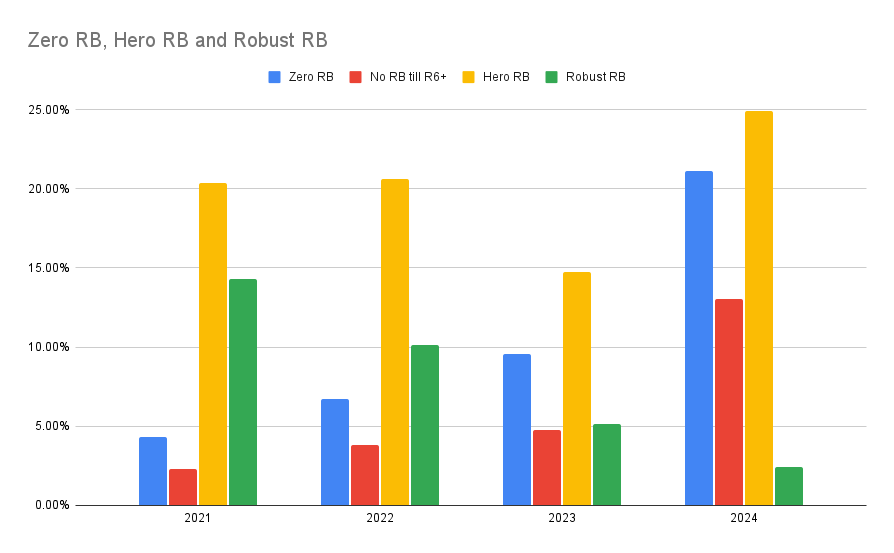
For those reasons, Zero RB is now popular. Rotoviz has an awesome best ball explorer tool, and Tom Strachan dug up just how dramatic Zero RB's rise in popularity on Underdog Fantasy over the last 4-5 years. His definitions in the chart above are: "Zero RB" = RB1 drafted exactly in Round 6, "0 RB till R6+" = RB1 drafted sometime after Round 6, "Hero RB" = RB1 in Rounds 1-3 but RB2 after Round 6, and "Robust RB" = RB3 through Round 4.
In short, the percentage of teams with 0 RBs through Round 5--which is my definition of Zero RB--has gone from 7% to 11% to 14% to 34%. That's nearly a 5x increase in just a few years. And despite WR prices being the highest they've ever been in fantasy football history last year, we even saw 13% of teams not draft a single RB until at least Round 7, which is Extreme Zero RB to me. That strategy was just 2.5% a few years ago.
Win The Flex
One issue: The more people that do Zero RB, the worse the strategy gets. A part of the reason for Zero RB is to have more fantasy points in the flex spot. A few years ago, the RB24 was being drafted ahead of the WR36, so the gap in projected fantasy points between RBs and WRs during the flex rounds was fairly flat. A team theoretically could go with another WR and not sacrifice expected fantasy points, while taking on less injury and benching risk. Smart!
But that's not how it looks in this 2025 ADP environment. I took the projected half PPR points from Mike Clay and Rich Hribar and plotted them against Underdog Fantasy's ADP in 2025. As you can see in the Flex Zone (shoutout to Rae Sremmurd), there are RBs who project for about 50 more points than the WRs or TEs available for that flex job. If the RBs were priced up like they were 4 and 5 years ago, this chart looks different.

But pre-season projections aren't everything and sometimes the best players available aren't RBs in our particular draft room, so let's dig into the data on how to properly build a Zero RB team anyway.
How Many WRs To Draft On Zero RB Teams
The first thing to figure out with Zero RB is how many WRs to draft at certain points of the draft. I like to look at things through Round 6, Round 10, and Round 18, and I like to look at teams from each of the last 5 years of data because there have been some Zero RB years, Hero RB years, Bi-Modal RB years, and Robust RB years. What has generally worked in all 5 years despite the ebbs and flows of each slate is a good starting point for how to build out strategies now that the sample size is growing.
4 WRs Through Round 6: In a Zero RB build, I generally like to have 4 WRs through Round 6, as it's been an above-average start in 4-of-5 years (just don't look at last year). The data lining up with the maximum number of potential starters (3 WRs + 1 FLEX) isn't a surprise to me because of diminishing returns. The second we start guaranteeing points on our bench early is the second we start guaranteeing opportunity cost. That said, having 5 WRs through Round 6 has been a good strategy in 2-of-5 years when there were clear-cut Zero RB hits.
5 WRs Through Round 10: This might seem less than people would think, but it also checks out to me. If we're investing into WRs really early in the draft, then we need to bank on their expected fantasy points. In fact, the only way to maximize on going with WRs in the first rounds is to stop drafting WRs in the middle rounds. Let's put some specifics to this now... 5-WR teams through Round 10 have finished with above-average points in 5-of-5 best ball slates. Seems good. There are some slates where having a 6th WR through Round 10 is an above-average strategy, but it's less true when the first few picks on those teams were WRs. For more on this topic, go here. And even in the two most extreme Zero RB years, it's been notably worse to have 7 WRs through Round 10 compared to these 4-, 5-, and 6-WR teams. That's diminishing returns live in the flesh.
6-7 WRs Through Round 18: The following comes from my Zero RB column from 3 offseasons ago, but the trend line still applies. "Teams that finished with 6 or 7 WRs after hammering the position early averaged just above a 20% advance rate, compared to a 15.7% win rate for teams that drafted 9 or 10 WRs after hammering the position early." And it continues, "Not only is drafting fewer WRs more productive, but it’s also more contrarian. There were only 3,622 teams that went the 6-7 WR route versus 8,415 teams that had 9-10 WRs. And the 8 WR teams (n = 8,054) were still performing worse than the 6-7 WR teams." In other words, the best Zero RB teams to me will be so WR-heavy early but so light in investment afterwards that they'll feel a little uncomfortable with just how pure our early-WRs have to run. If that's the feeling you get, then you're probably running fast enough in the required catch up at RB.
How Many RBs To Draft On Zero RB Teams
The second key thing is to figure out with Zero RB is how many RBs to draft at certain points of the draft.
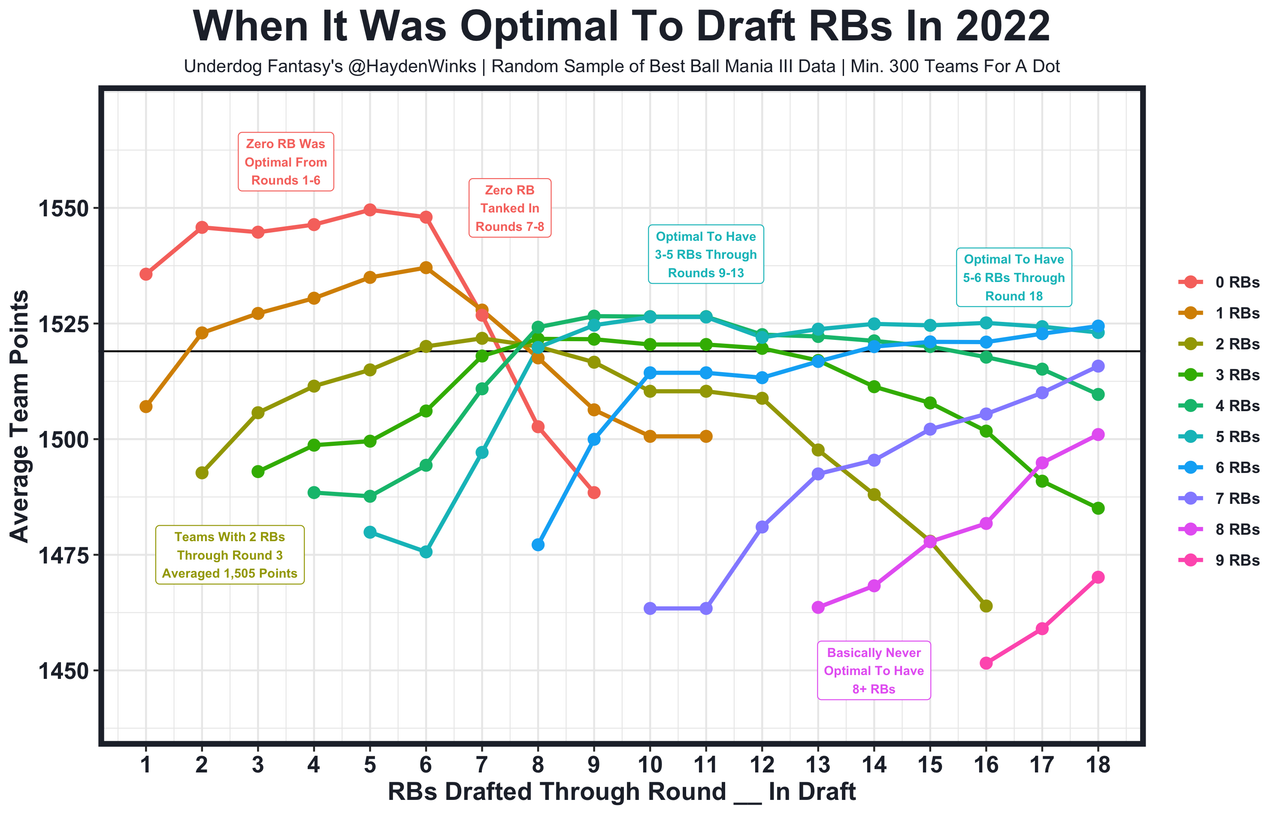
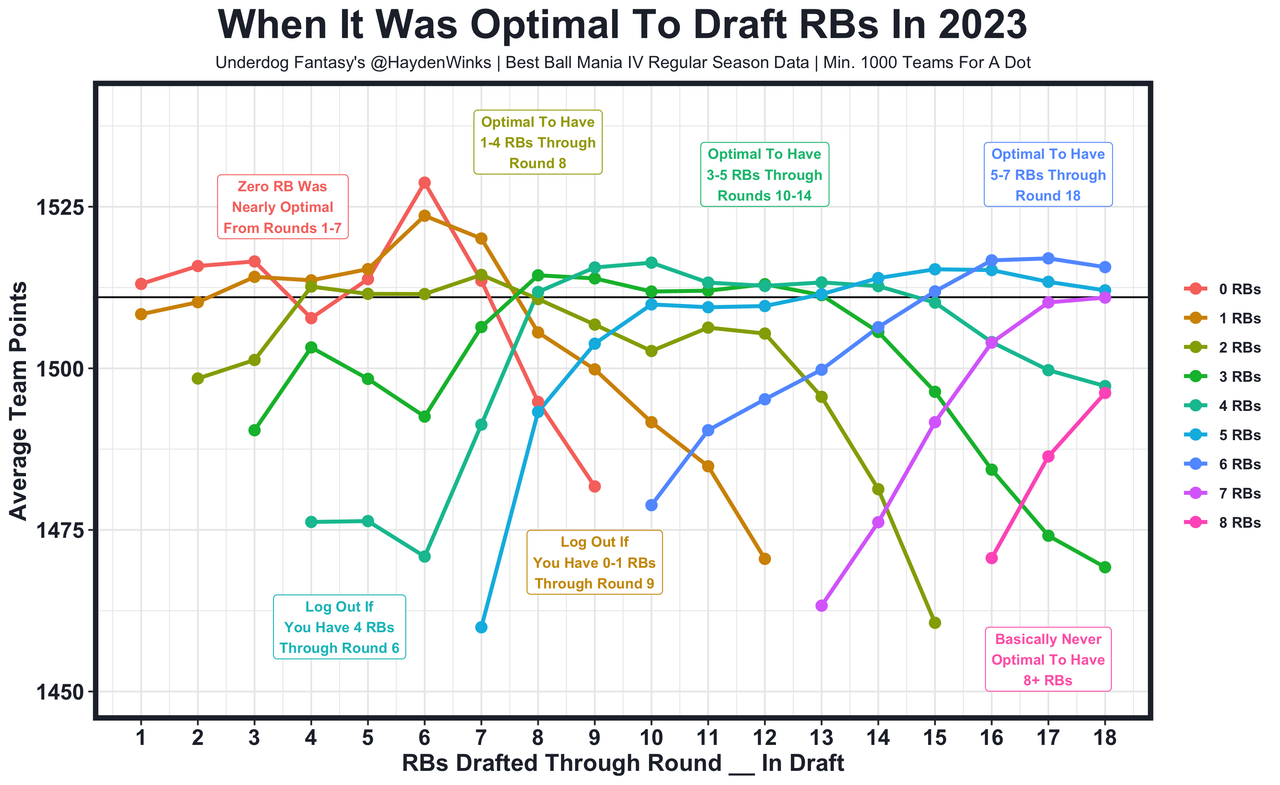
Round 7 Is The Latest To Draft RB1: The two biggest smash years in modern Zero RB history came in 2022 and 2023. The red dots and lines in the charts above show how well teams without an RB1 did through each round. Zero RB teams peaked in Round 5/6 during the 2022 season and in Round 6 during the 2023 season, but in both slates, Zero RB teams suffered pretty dramatically if they didn't have their RB1 through Round 7. In fact, teams without an RB1 through Round 8 have clearly had their asses handed to them in all 5 Best Ball Mania seasons, so there's been a clear indication of when things have been pushed too far. In general, the latest a Zero RB team should push their luck is through Round 6. If I studied Full PPR data, then perhaps it's through Round 7, but I think the law of diminishing returns simply takes over compared to the starting lineups we have to fill. I just don't think a 1QB-0RB-5WR-1TE team is going to be better than a QB1-1RB-4WR-1TE team in a large majority of slates for example.
3-5 RBs Through Round 10: Take a look at the same two charts from above, but now let's pay attention to Round 10 datapoints. It's clear that having only 1 or 2 RBs through Round 10 is very clearly worse than having 3, 4, or 5 RBs, and as a reminder, these are the slates where Zero RB has been the optimal strategy. This checks out intuitively because these Zero RB teams still need fantasy points from their RBs, so they have to win with volume as soon as they can after hammering WRs early. Specifically, the difference between having exactly 3, 4, or 5 RBs through Round 10 has been extremely marginal, but if you want the exact answer, 4 has been the optimal amount of RBs through Round 10 after a Zero RB start. That means it requires a very hard turn back towards RB after not getting one early on.
6 RBs Through Round 18: The optimal amount of RBs to have through the end of an Underdog Fantasy draft during both of these pure Zero RB years has been exactly 6. This falls at the upper bounds of my general advice of having 4-6 RBs, which once again checks out. We need to win with more quantity of RB picks when we don't invest into quality RBs early on. And it's interesting that in both of these years it's still been better to have 5 RBs compared to 7 RBs. In the seasons where early RB investments have shined, 7-RB teams have been really bad, so the general advice is to stick with 6 RBs after sprinting back into RBs in the middle rounds. This would line up with the projected fantasy points in the "Flex Zone" chart from above because RBs in Round 16-18 are typically horrific.

2025 Zero RB Targets
Now that there's a recommended path on when to draft RBs, let's figure out which players to actually draft. I'll put my targets into a couple of buckets because these Zero RB teams need a combination of RBs who can provide some level of value right away and other RBs who can provide potential top-15 RB stints if things break their way. I don't think building teams solely in one player archetype is the best way to make this strategy hum, so let's find a few names in each bucket:
"CPR RBs": These guys will keep us alive momentarily until more help arrives later.
Round 5-7 RBs: Hubbard, Mixon, Walker, Kamara, Conner, Kaleb, Pacheco.
Round 8-10 RBs: BRob, Etienne, Rhamondre, Dobbins.
"Contingent RBs": These players don't do anything for our teams until the starter is out.
Round 8-10 RBs: Mason, Charbonnet, Skattebo.
Round 11-14 RBs: Spears, Davis, White, Allgeier, Guerendo, Benson.
Round 15-18 RBs: Wright, Dowdle, Shipley, Sanders, Hunter, Lloyd.
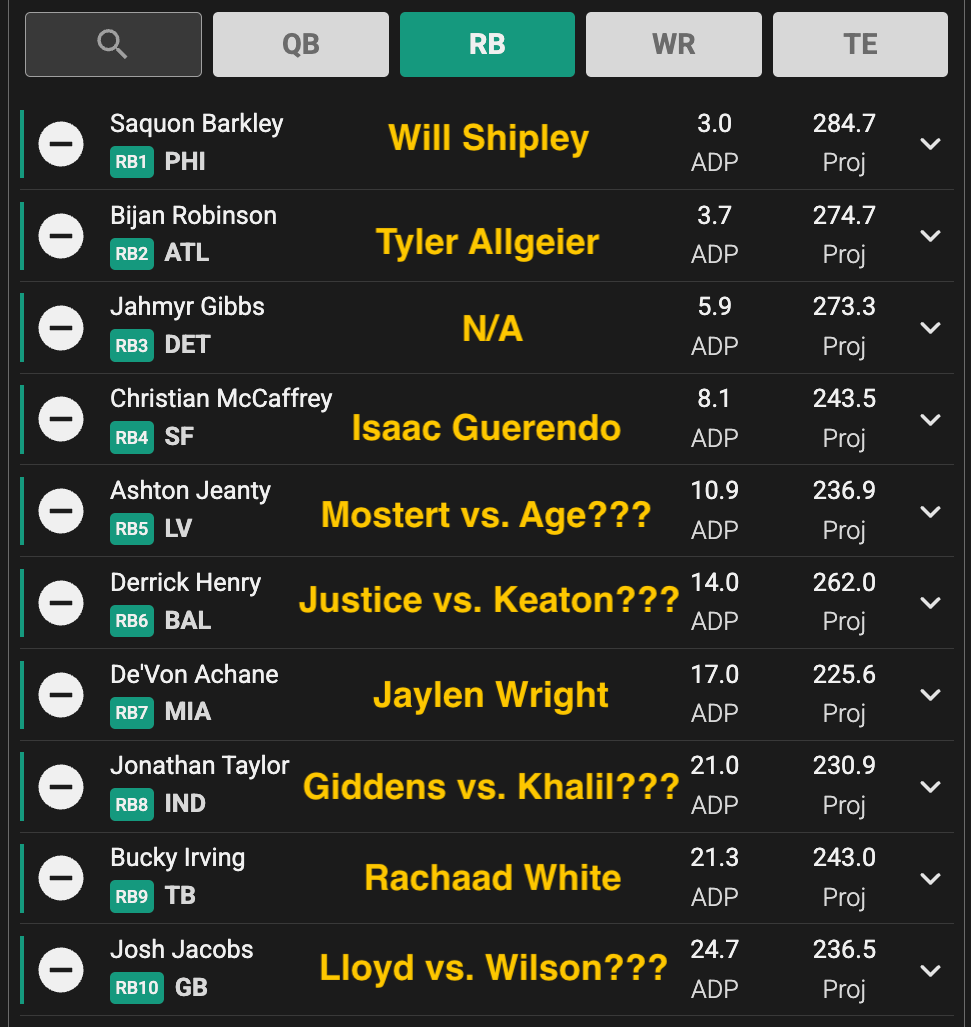
A 2025 Zero RB Mock Draft
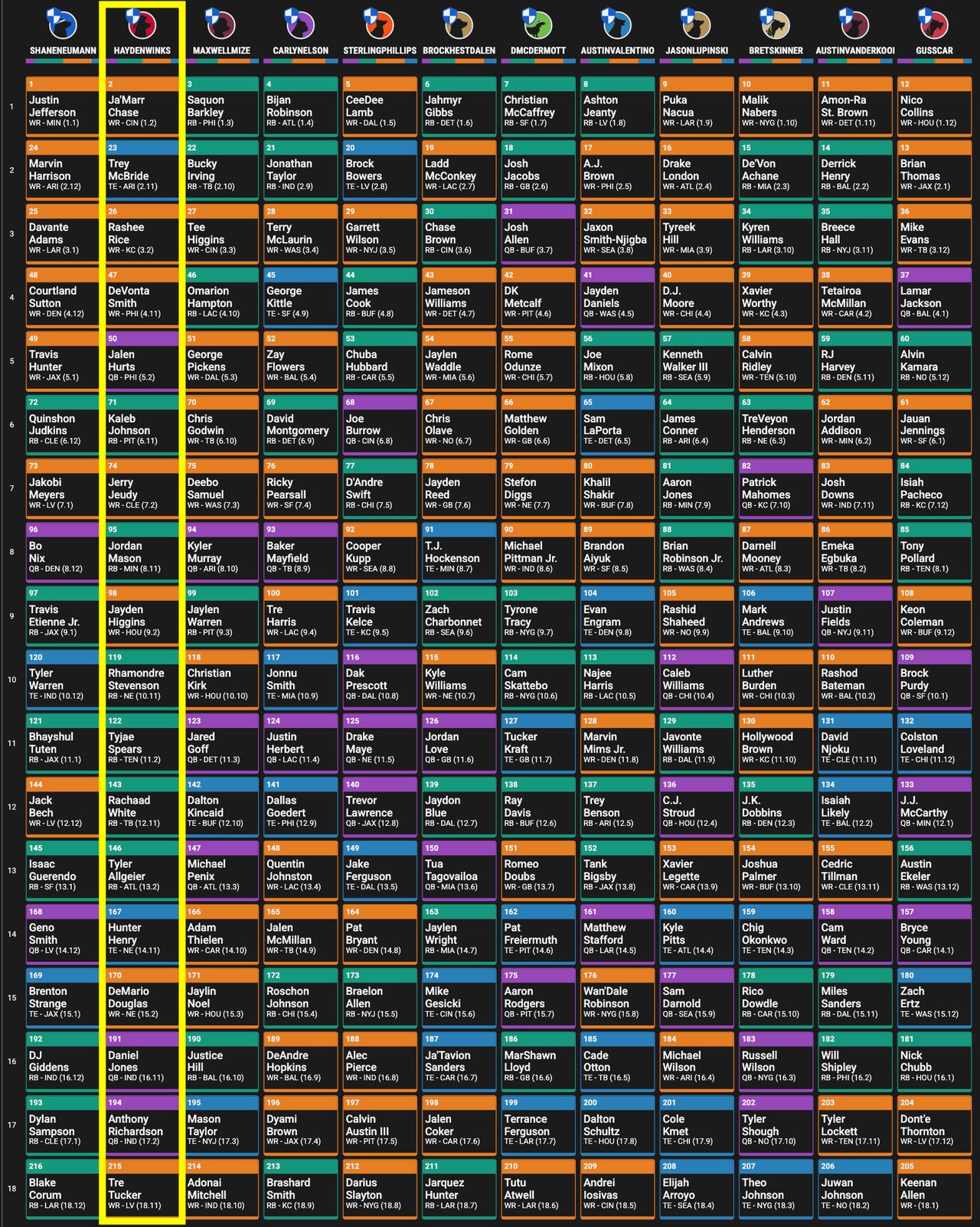
This is a team I drafted on June 27th against Underdog Fantasy co-workers, which I drafted before writing and researching this column. Let's grade this team, now knowing what we should exactly be doing.
4 WRs through Round 6 ☑️
I technically only had 3 WRs, but WR4 was at 7.02. Close enough, especially when I have the consensus WR1 overall.
5 WRs through Round 10 ✅
WR5 was in Round 9. WR6 not until Round 15.
6-7 WRs through Round 18 ✅
I had 7, but the last two were really late.
RB1 before Round 7 ✅
Kaleb Johnson in Round 6.
3-5 RBs through Round 10 ✅
3 RBs with RB4, RB5, and RB6 coming immediately after.
6 RBs through Round 18 ✅
I stopped at 6 after the RB6 was drafted in Round 13, which is on the early side but was justified after being really light through Round 10.
QB1 to pass catcher stack ✅
Hurts to Smith.
Late-round team stack ✅
Patriots (Stevenson, Henry, Douglas).
Normal final roster construction ✅
3-6-7-2.
This is as close to an ideal Zero RB team for Underdog Fantasy in 2025, and it wasn't forced. A few things fell into my lap to justify the contrarian strategy: Ja'Marr Chase at 1.02, all the RBs going before 2.11, Rashee Rice falling to 3.02, and stacking Hurts and Smith at Round 4/5. If any of these things don't happen, I likely find a RB value before Round 6, but something like this happens naturally in 1-in-10 drafts or so. Now I feel very prepared to draft this styled team as a change up.
I genuinely appreciate anyone for reading, and I hope we all learned something along the way. I'm glad there are still dozens of us who will actually read something in 2025. You definitely earned 30 minutes of doom scrolling on TikTok. Enjoy.